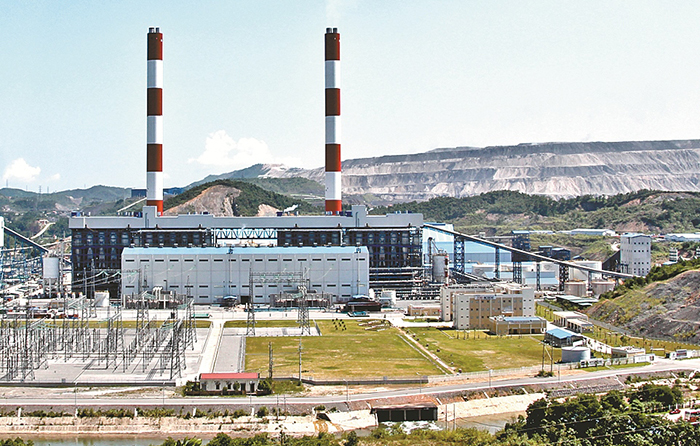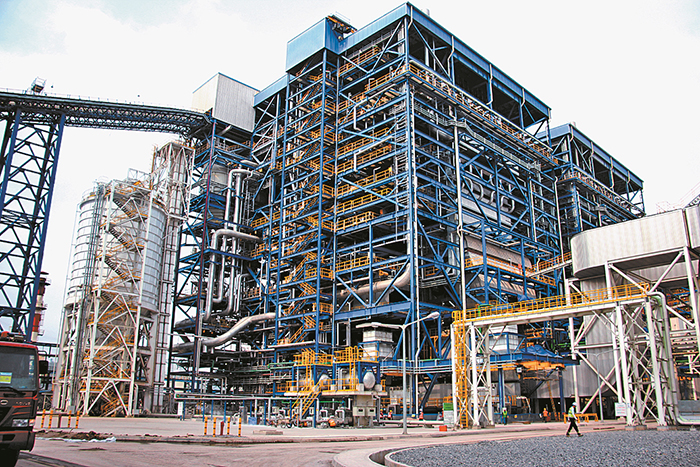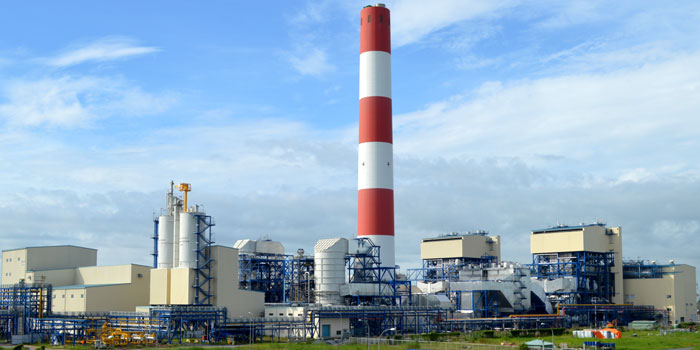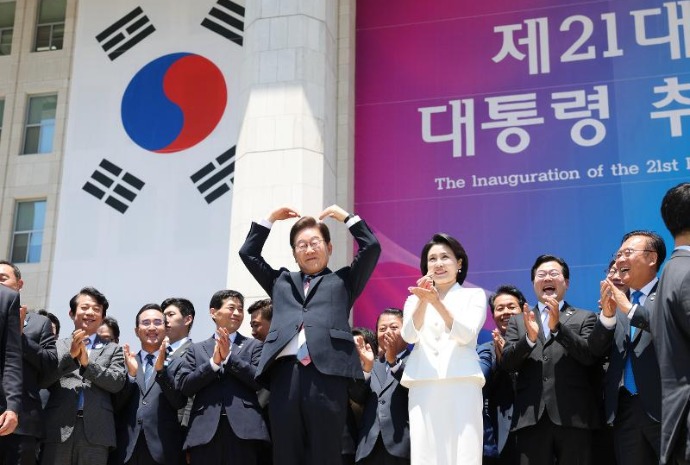Mong Duong, Phalai, O Mon and Quynh Lap. These are all regions in Vietnam where Korean construction companies either built or are building power plants for the rapidly growing Southeast Asian economy.
Korean builders are actively working to solve the problem of an insufficient electricity supply in Vietnam, caused by rapid economic development over the past few years.
In January this year, Hyundai Engineering and Construction (Hyundai E&C) completed the Mong Duong 1 Thermal Power Plant in Mong Duong, Cam Pha City, in Quang Ninh Province, some 250 kilometers northeast of Hanoi. This plant can produce up to 6.5 billion kilowatts per hour annually, which 5.1 million people can use for one year.

Hyundai E&C received the order for this project in 2011. It was a state-funded project by the Vietnamese government in order to solve the chronic lack of energy. Hyundai finished the second unit at the plant last December, and has been test-running the plant since January this year.
The most noticeable part of the plant is that it's the first power plant in Vietnam where a circulating fluidized bed combustion (CFBC) boiler is used. CFBC boiler technology can increase heat efficiency even if low-quality bituminous coal is used, unlike many other thermal power plant designs that require high-quality bituminous coal.
Vietnam has an abundant amount of anthracite in its northern regions. However, most of it is unable to use as pulverized coal, the fuel for the thermal power plant, because it has too few calories, a measurement of energy.
CFBC boilers can break low-quality bituminous coal into smaller sizes, from about five up to 20 millimeters across. This can boost heat efficiency thanks to a complete combustion system that's designed to use such fine coal and to burn the remainder again and again. As both air and limestone are injected and combusted at the same time, it is an environmentally friendly power generation technology, as it can reduce emissions of pollutants such as nitrogenous compounds and antioxidants.

Hyundai previously built the Phalai Power Plant in 1998, ahead of the Mong Duong 1 Thermal Power Plant. At that time, Hyundai was in charge of the construction only. Unlike the Phalai Power Plant, however, Hyundai is now in charge of the entire project, from the design and purchase through to the final construction.
In Mong Duong, there is now another power plant -- the Mong Duong Ⅱ Coal-fired Power Plant -- completed by Korea’s Doosan Heavy Industries & Construction in October 2015. Over the next 25 years, this plant will be jointly managed and operated by Korea’s Posco Energy, the AEC Corporation and the China Investment Corporation. Its installed capacity is estimated at 1,120 megawatts and it's equipped with environmentally friendly facilities, such as a flue gas desulphurisation (FGD) system and equipment to perform selective catalytic reductions.
Korea's POSCO Energy, further plans to build a coal-fired power plant in Quynh Lap, in Nghe An Province, 270 kilometers south of Hanoi. To this aim, POSCO and the local government of Nghe An Province signed a memorandum of understanding covering the construction of the Quynh Lap II coal-fired power plant on Feb. 21.
The project aims at building a 1,200 megawatt coal-fired power plant at the Nghe An Southeast Economic Zone. This is a “build-operate-transfer” (BOT) project in which the plant will be run by a private investor for a certain amount of time and then be transferred to the Vietnamese government.

Finally, Daelim Industrial has been building a gas and oil thermal power plant in O Mon, in Cantho Province, in the delta region of the Mekong River in southeast Vietnam. Since August 2012 when Daelim won the bid, it has been working with Japan’s Sojitz Corporation as part of a consortium.
The project aims to build a 330 megawatt gas and oil thermal power plant by October 2016. Daelim is in charge of the detailed design, and of supplying, constructing and test-operating core facilities at the plant, such as the power block and the boilers.
By Yoon Sojung
Korea.net Staff Writer
arete@korea.kr
Korean builders are actively working to solve the problem of an insufficient electricity supply in Vietnam, caused by rapid economic development over the past few years.
In January this year, Hyundai Engineering and Construction (Hyundai E&C) completed the Mong Duong 1 Thermal Power Plant in Mong Duong, Cam Pha City, in Quang Ninh Province, some 250 kilometers northeast of Hanoi. This plant can produce up to 6.5 billion kilowatts per hour annually, which 5.1 million people can use for one year.

Hyundai E&C completes the Mong Duong 1 Thermal Power Plant in Mong Duong this past January. It can produce 6.5 billion kilowatts of electricity a year.
Hyundai E&C received the order for this project in 2011. It was a state-funded project by the Vietnamese government in order to solve the chronic lack of energy. Hyundai finished the second unit at the plant last December, and has been test-running the plant since January this year.
The most noticeable part of the plant is that it's the first power plant in Vietnam where a circulating fluidized bed combustion (CFBC) boiler is used. CFBC boiler technology can increase heat efficiency even if low-quality bituminous coal is used, unlike many other thermal power plant designs that require high-quality bituminous coal.
Vietnam has an abundant amount of anthracite in its northern regions. However, most of it is unable to use as pulverized coal, the fuel for the thermal power plant, because it has too few calories, a measurement of energy.
CFBC boilers can break low-quality bituminous coal into smaller sizes, from about five up to 20 millimeters across. This can boost heat efficiency thanks to a complete combustion system that's designed to use such fine coal and to burn the remainder again and again. As both air and limestone are injected and combusted at the same time, it is an environmentally friendly power generation technology, as it can reduce emissions of pollutants such as nitrogenous compounds and antioxidants.

Hyundai E&C uses an environmentally friendly technology at the Mong Duong 1 Thermal Power Plant.
Hyundai previously built the Phalai Power Plant in 1998, ahead of the Mong Duong 1 Thermal Power Plant. At that time, Hyundai was in charge of the construction only. Unlike the Phalai Power Plant, however, Hyundai is now in charge of the entire project, from the design and purchase through to the final construction.
In Mong Duong, there is now another power plant -- the Mong Duong Ⅱ Coal-fired Power Plant -- completed by Korea’s Doosan Heavy Industries & Construction in October 2015. Over the next 25 years, this plant will be jointly managed and operated by Korea’s Posco Energy, the AEC Corporation and the China Investment Corporation. Its installed capacity is estimated at 1,120 megawatts and it's equipped with environmentally friendly facilities, such as a flue gas desulphurisation (FGD) system and equipment to perform selective catalytic reductions.
Korea's POSCO Energy, further plans to build a coal-fired power plant in Quynh Lap, in Nghe An Province, 270 kilometers south of Hanoi. To this aim, POSCO and the local government of Nghe An Province signed a memorandum of understanding covering the construction of the Quynh Lap II coal-fired power plant on Feb. 21.
The project aims at building a 1,200 megawatt coal-fired power plant at the Nghe An Southeast Economic Zone. This is a “build-operate-transfer” (BOT) project in which the plant will be run by a private investor for a certain amount of time and then be transferred to the Vietnamese government.

The gas and oil thermal power plant in O Mon is being built by Daelim Industrial. Construction will be completed this October.
Finally, Daelim Industrial has been building a gas and oil thermal power plant in O Mon, in Cantho Province, in the delta region of the Mekong River in southeast Vietnam. Since August 2012 when Daelim won the bid, it has been working with Japan’s Sojitz Corporation as part of a consortium.
The project aims to build a 330 megawatt gas and oil thermal power plant by October 2016. Daelim is in charge of the detailed design, and of supplying, constructing and test-operating core facilities at the plant, such as the power block and the boilers.
By Yoon Sojung
Korea.net Staff Writer
arete@korea.kr
